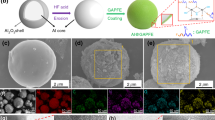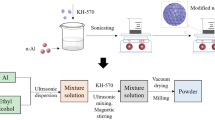Abstract
The application of aluminum nanoparticle is limited due to its passivation Al2O3 layer even though it owns extreme specific surface and high reaction activity. In this work, the aluminum nanoparticles were modified via in situ grafting onto energetic glycidyl azide polymer (GAP) to improve the stability and energy-releasing performance. The results showed that GAP was grafted on the nano-aluminum surface with chemical bonds of –O–(CO–NH)– formed, and the thickness of shell layer of GAP could be tuned by changing the relative ratio of reactants. Furthermore, modified nanoparticles show hydrophobicity with static water contact angle changing from 20.2° to 142.4°. Significant increasing stability of aluminum nanoparticles is obtained in hot water, which is evidenced by that around 10 wt% of modified aluminum is reacted after 210 min. Based on the core–shell configurations, (Al@GAP)/fluorine composites were prepared. The violent combustion phenomenon and high release rate profiles revealed high energy-releasing performance with the assistance of GAP. This synthetic strategy may provide an effective approach to prepare other metal nanoparticles, and possess potential application value in the fields of metallized explosives and high-energy structure with energy release.










Similar content being viewed by others
References
Arkhipov VA, Korotkikh AG (2012) The influence of aluminum powder dispersity on composite solid propellants ignitability by laser radiation. J Combust Flame 159:409–415
Wen A, Liu PJ, Yang WJ (2016) Agglomerates, smoke oxide particles, and carbon inclusions in condensed combustion products of an aluminized GAP-based propellant. Acta Astronaut 129:147–153
Patel VK, Ganguli A, Kant R, Bhattacharya S (2015) Micropatterning of nanoenergetic films of Bi2O3/Al for pyrotechnics. RSC Adv 5:14967–14973
Su Y, Meguid SA (2016) Multiphysics modeling and characterization of explosively loaded aluminum blocks. Acta Mech 227:707–720
Manner VW, Pemberton SJ, Gunderson JA, Herrera TJ, Lloyd JM, Salazar PJ, Rae P, Tappan BC (2012) The role of aluminum in the detonation and post-detonation expansion of selected cast HMX-based explosives. Propellants Explos Pyrotech 337:198–206
Broussean P (2002) Nanometric Al in explosive. Propellants Explos Pyrotech 27:300–306
Tyagi H, Phelan PE, Prasher R, Peck R, Lee T, Pacheco JR, Arentzen P (2008) Increased hot-plate ignition probability for nanoparticle-laden diesel fuel. Nano Lett 5:1410–1416
DeLuca LT, Galfetti L, Severini F, Meda L, Marra G, Vorozhtsov AB, Sedoi VS, Babuk VA (2005) Burning of nano-aluminized composite rocket propellants. Combust Explos Shock 6:680–692
Pantoya ML, Grantier JJ (2005) Combustion behavior of highly energetic thermites: nano versus micron composites. Propellants Explos Pyrotech 1:53–62
Valliappan S, Swiatkiewicz J, Puszynski JA (2005) Reactivity of aluminum nanopowders with metal oxides. Powder Technol 156:164–169
Yang Y, Wang PP, Zhang ZC, Liu HL, Zhang J, Zhuang J, Wang X (2013) Nanowire membrane-based nanothermite: towards processable and tunable interfacial diffusion for solid state reactions. Sci Rep 3:1694
Dong ZZ, Al-Sharab JF, Kear BH, Tse SD (2013) Combined flame and electrode position synthesis of energetic coaxial tungsten-oxide/aluminum nanowire arrays. Nano Lett 13:4346–4350
Chung SW, Guliants EA, Bunker CE, Hammerstroem DW, Deng Y, Burgers MA, Jelliss PA, Buckner SW (2009) Capping and passivation of aluminum nanoparticles using alkyl-substituted epoxides. Langmuir 25:8883–8887
Hammerstroem DW, Burgers MA, Chung SW, Gulians EA, Bunker CE, Wentz KM, Hayes SE, Buckner SW, Jelliss PA (2011) Aluminum nanoparticles capped by polymerization of alkyl-substituted epoxides: ratio-dependent stability and particle Size. Inorg Chem 50:5054–5059
He GS, Yang ZJ, Zhou XY, Zhang JL, Pan LP, Liu SJ (2016) Polymer bonded explosives (PBXs) with reduced thermal stress and sensitivity by thermal conductivity enhancement with grapheme nanoplatelets. Compos Sci Technol 131:22–31
Yetter RA, Risha GA, Son SF (2009) Metal particle combustion and nanotechnology. Proc Combust Inst 32:1819–1838
Rubio MA, Gunduz IE, Groven LJ, Sippel TR, Han CW, Unocic RR, Ortalan V, Son SF (2017) Microexplosions and ignition dynamics in engineered aluminum/polymer fuel particles. J Combust Flame 176:162–171
Andrzejak TA, Shafirovich E, Varma A (2007) Ignition mechanism of nickel-coated aluminum particles. J Combust Flame 150:60–70
Hahma A (2010) Method of improving the burn rate and ignitability of aluminum fuel particles and aluminum fuel so modified. US 7,785,430, B2, 31 Aug 2010
Jouet RJ, Warren AD, Rosenberg DM, Bellitto VJ, Park K, Zachariah MR (2005) Surface passivation of bare aluminum nanoparticles using perfluoroalkyl carboxylic acids. Chem Mater 17:2987–2996
Kwon YS, Alexander AG, Julia IS (2007) Passivation of the surface of aluminum nanopowders by protective coatings of the different chemical origin. Appl Surf Sci 253:5558–5564
Mohseni M, Mirabedini M, Hashemi M, Thompson GE (2006) Adhesion performance of an epoxy clear coat on aluminum alloy in the presence of vinyl and amino-sliane primers. Prog Org Coat 57:307–313
Attavar S, Diwekar M, Linford MR, Davis MA, Blair S (2010) Passivation of aluminum with alkyl phosphonic acids for biochip applications. Appl Surf Sci 256:7146–7150
Pauly CS, Genix AC, Alauzun JG, Sztucki M, Oberdisse J, Mutin PH (2015) Surface modification of alumina-coated silica nanoparticles in aqueous sols with phosphonic acids and impact on nanoparticle interactions. Phys Chem Chem Phys 17:19173–19182
Atmane YA, Sicard L, Lamouri A, Pinson J, Sicard M, Masson C, Nowak S, Decorse P, Piquemal JY, Galtayries A, Mangeney C (2013) Functionalization of aluminum nanoparticles using a combination of aryl Diazonium salt chemistry and iniferter method. J Phys Chem C 117:26000–26006
Gong FY, Liu XB, Wang L, Liu JH (2014) Surface grafting with energetic glycidyl azide polymer(GAP): an efficient way to process ultrafine aluminum powders. In: New trends in research and energetic materials, Czech Republic
Liu XB, Pan LP, Zhang JH, Gong FY (2015) Properties of ultrafine aluminum powders modified by facile grafting with glycidyl azide polymer. Chin J Energ Mater 23:813–816
Kuwahara T, Takizuka M, Onda T (2000) Combustion of GAP based energetic pyrolants. Propellants Explos Pyrotech 25:112–116
Balazs AC, Emrick T, Russell TP (2006) Nanoparticle polymer composites: where two small worlds meet. Science 314:1107–1110
Hagen TH, Jensen TL, Unneberg E, Stenstrom YH, Kristensen TE (2015) Curing of glycidyl azide polymer (GAP) diol using isocyanate, isocyanate-free, synchronous dual, and sequential dual curing systems. Propellants Explos Pyrotech 40:275–284
Keicher T, Kuglstatter W, Eisele S, Wetzel T, Krause H (2009) Isocyanate-free curing of glycidyl azide polymer(GAP) with bis-propargyl-succinate(II). Propellants Explos Pyrotech 34:210–217
Ramaswamy AL, Kaste P (2004) T.S. F.revino, A “micro-vision” of the physio-chemical phenomena occurring in nanoparticles of aluminum. J Energ Mater 21:1–24
Kassaee MZ, Buazar F (2009) Al nanoparticles impact of media and current on the arc fabrication. J Manuf Process 11:31–37
Fernando KA, Smith MJ, Harruff BA, Lewis WK, Guliants EA, Bunker CE (2009) Sonochemically assisted thermal decomposition of alane N, N-dimethylethylamine with titanium(IV) isopropoxide in the presence of oleic acid to yield air-stable and size-selective aluminum core–shell nanoparticles. J Phys Chem C 113:500–503
Gouget-Laemmel AC, Yang J, Lodhi MA, Siriwardena A, Aureau D, Boukherroub R, Chazalviel JN, Ozanam F, Szunerits S (2013) Functionalization of azide-terminated silicon surfaces with glycans using click chemistry: XPS and FTIR study. J Phys Chem C 117:368–375
Bhairamadgi NS, Gangarapu S, Campos MAC, Paulusse JMJ, Rijn CJM, Zuilhof H (2013) Efficient functionalization of oxide-free silicon (111) surfaces: Thiol-yne versus thiol-ene click chemistry. Langmuir 29:4535–4542
Enman J, Ramser K, Rova U, Berglund KA (2008) Raman analysis of synthetic eritadenine. J Raman Spectrosc 39:1464–1468
Meda L, Nicastro C, Conte F, Cerofolini GF (2000) Experimental valuation of net atomic charge via XPS. Surf Interface Anal 29:851–855
Shin WG, Han D, Park Y, Hyun HS, Sung HG, Sohn YK (2016) Combustion of boron particles coated with an energetic polymer material. Korean J Chem Eng 33:3016–3020
Crouse CA, Pierce CJ, Spowart JE (2012) Synthesis and reactivity of aluminized fluorinated acrylic (AlFA) nanocomposites. Combust Flame 159:3199–3200
Wang QG, Zhang J, Zhang F (2009) The principle and application of the cone calorimeter. Mod Sci Instrum 6:36–39
Acknowledgements
This work was supported by the National Natural Science Foundation of China (Grant Numbers 11402238, 11502242, 11702267).
Author information
Authors and Affiliations
Corresponding authors
Electronic supplementary material
Below is the link to the electronic supplementary material.
Rights and permissions
About this article
Cite this article
Zeng, C., Wang, J., He, G. et al. Enhanced water resistance and energy performance of core–shell aluminum nanoparticles via in situ grafting of energetic glycidyl azide polymer. J Mater Sci 53, 12091–12102 (2018). https://doi.org/10.1007/s10853-018-2503-1
Received:
Accepted:
Published:
Issue Date:
DOI: https://doi.org/10.1007/s10853-018-2503-1




